Balbharti 12th Maharashtra State Board Maths Solutions Book Pdf Chapter 3 Trigonometric Functions Miscellaneous Exercise 3 Questions and Answers.
12th Maths Part 1 Trigonometric Functions Miscellaneous Exercise 3 Questions And Answers Maharashtra Board
I) Select the correct option from the given alternatives.
Question 1.
The principal of solutions equation sinθ = \(\frac{-1}{2}\) are ________.
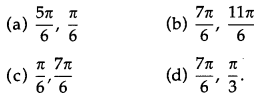
Solution:
(b) \(\frac{7 \pi}{6}, \frac{11 \pi}{6}\)
Question 2.
The principal solution of equation cot θ = \(\sqrt {3}\) ___________.
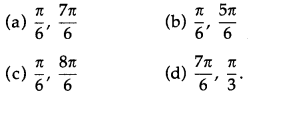
Solution:
(a) \(\frac{\pi}{6}, \frac{7 \pi}{6}\)
Question 3.
The general solution of sec x = \(\sqrt {2}\) is __________.
(a) 2nπ ± \(\frac{\pi}{4}\), n ∈ Z
(b) 2nπ ± \(\frac{\pi}{2}\), n ∈ Z
(c) nπ ± \(\frac{\pi}{2}\), n ∈ Z
(d) 2nπ ± \(\frac{\pi}{3}\), n ∈ Z
Solution:
(a) 2nπ ± \(\frac{\pi}{4}\), n ∈ Z
Question 4.
If cos pθ = cosqθ, p ≠ q rhen ________.
(a) θ = \(\frac{2 n \pi}{p \pm q}\)
(b) θ = 2nπ
(c) θ = 2nπ ± p
(d) nπ ± q
Solution:
(a) θ = \(\frac{2 n \pi}{p \pm q}\)

Question 5.
If polar co-ordinates of a point are \(\left(2, \frac{\pi}{4}\right)\) then its cartesian co-ordinates are ______.
(a) (2, \(\sqrt {2}\) )
(b) (\(\sqrt {2}\), 2)
(c) (2, 2)
(d) (\(\sqrt {2}\) , \(\sqrt {2}\))
Solution:
(d) (\(\sqrt {2}\) , \(\sqrt {2}\))
Question 6.
If \(\sqrt {3}\) cosx – sin x = 1, then general value of x is _________.
(a) 2nπ ± \(\frac{\pi}{3}\)
(b) 2nπ ± \(\frac{\pi}{6}\)
(c) 2nπ ± \(\frac{\pi}{3}-\frac{\pi}{6}\)
(d) nπ + (-1)
n
\(\frac{\pi}{3}\)
Solution:
(c) 2nπ ± \(\frac{\pi}{3}-\frac{\pi}{6}\)
Question 7.
In ∆ABC if ∠A = 45°, ∠B = 60° then the ratio of its sides are _________.
(a) 2 : \(\frac{\pi}{2}\) : \(\frac{\pi}{3}\) + 1
(b) \(\frac{\pi}{2}\) : 2 : \(\frac{\pi}{3}\) + 1
(c) 2 \(\frac{\pi}{2}\) : \(\frac{\pi}{2}\) : \(\frac{\pi}{3}\)
(d) 2 : 2 \(\frac{\pi}{2}\) : \(\frac{\pi}{3}\) + 1
Solution:
(a) 2 : \(\frac{\pi}{2}\) : \(\frac{\pi}{3}\) + 1

Question 8.
In ∆ABC, if c
2
+ a
2
– b
2
= ac, then ∠B = __________.
(a) \(\frac{\pi}{4}\)
(b) \(\frac{\pi}{3}\)
(c) \(\frac{\pi}{2}\)
(d) \(\frac{\pi}{6}\)
Solution:
(b) \(\frac{\pi}{3}\)
Question 9.
In ABC, ac cos B – bc cos A = ____________.
(a) a
2
– b
2
(b) b
2
– c
2
(c) c
2
– a
2
(d) a
2
– b
2
– c
2
Solution:
(a) a
2
– b
2
Question 10.
If in a triangle, the are in A.P. and b : c = \(\sqrt {3}\) : \(\sqrt {2}\) then A is equal to __________.
(a) 30°
(b) 60°
(c) 75°
(d) 45°
Solution:
(c) 75°

Question 11.
cos
-1
\(\left(\cos \frac{7 \pi}{6}\right)\) = ________.
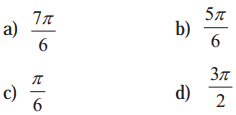
Question 12.
The value of cot (tan
-1
2x + cot
-1
2x) is __________.
(a) 0
(b) 2x
(c) π + 2x
(d) π – 2x
Solution:
(a) 0
Question 13.
The principal value of sin
-1
\(\left(-\frac{\sqrt{3}}{2}\right)\) is ____________.
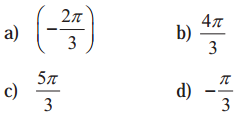
Solution:
(d) \(-\frac{\pi}{3}\)

Question 14.
If sin
-1
\(\frac{4}{5}\) + cos
-1
\(\frac{,12}{13}\) = sin
-1
∝, then ∝ = _____________.
(a) \(\frac{63}{65}\)
(b) \(\frac{62}{65}\)
(c) \(\frac{61}{65}\)
(d) \(\frac{60}{65}\)
Solution:
(a) \(\frac{63}{65}\)
Question 15.
If tan
-1
(2x) + tan
-1
(3x) = \(\frac{\pi}{4}\), then x = ________.
(a) -1
(b) \(\frac{1}{6}\)
(c) \(\frac{2}{6}\)
(d) \(\frac{3}{2}\)
Solution:
(b) \(\frac{1}{6}\)
Question 16.
2 tan
-1
\(\frac{1}{3}\) + tan
-1
\(\frac{1}{7}\) = ______.
(a) tan
-1
\(\frac{4}{5}\)
(b) \(\frac{\pi}{2}\)
(c) 1
(d) \(\frac{\pi}{4}\)
Solution:
(d) \(\frac{\pi}{4}\)

Question 17.
tan (2 tan
-1
\(\left(\frac{1}{5}\right)-\frac{\pi}{4}\)) = ______.
(a) \(\frac{17}{7}\)
(b) \(-\frac{17}{7}\)
(c) \(\frac{7}{17}\)
(d) \(-\frac{7}{17}\)
Solution:
(d) \(-\frac{7}{17}\)
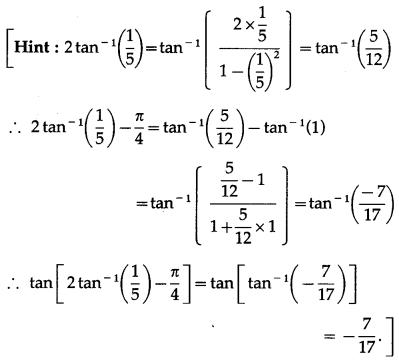
Question 18.
The principal value branch of sec
-1
x is __________.

Solution:
(b) [0, π] – {\(\frac{\pi}{2}\)}
Question 19.
cos[tan
-1
\(\frac{1}{3}\) + tan
-1
\(\frac{1}{2}\)] = ________.
(a) \(\frac{1}{\sqrt{2}}\)
(b) \(\frac{\sqrt{3}}{2}\)
(c) \(\frac{1}{2}\)
(d) \(\frac{\pi}{4}\)
Solution:
(a) \(\frac{1}{\sqrt{2}}\)

Question 20.
If tan θ + tan 2θ + tan 3θ = tan θ∙tan 2θ∙tan 3θ, then the general value of the θ is _______.
(a) nπ
(b) \(\frac{n \pi}{6}\)
(c) nπ ± \(\frac{n \pi}{4}\)
(d) \(\frac{n \pi}{2}\)
Solution:
(b) \(\frac{n \pi}{6}\)
[Hint: tan(A + B + C) = \(\frac{\tan A+\tan B+\tan C-\tan A \cdot \tan B \cdot \tan C}{1-\tan A \cdot \tan B-\tan B \cdot \tan C-\tan C \cdot \tan A}\)
Since , tan θ + tan 2θ + tan 3θ = tan θ ∙ tan 2θ ∙ tan 3θ,
we get, tan (θ + 2θ + 3θ) = θ
∴ tan6θ = 0
∴ 6θ = nπ, θ = \(\frac{n \pi}{6}\).]
Question 21.
If any ∆ABC, if a cos B = b cos A, then the triangle is ________.
(a) Equilateral triangle
(b) Isosceles triangle
(c) Scalene
(d) Right angled
Solution:
(b) Isosceles triangle
II: Solve the following
Question 1.
Find the principal solutions of the following equations :
(i) sin2θ = \(-\frac{1}{2}\)
Solution:
sin2θ = \(-\frac{1}{2}\)
Since, θ ∈ (0, 2π), 2∈ ∈ (0, 4π)
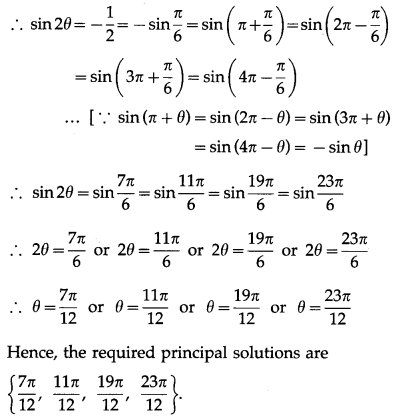
(ii) tan3θ = -1
Solution:
Since, θ ∈ (0, 2π), 3∈ ∈ (0, 6π)
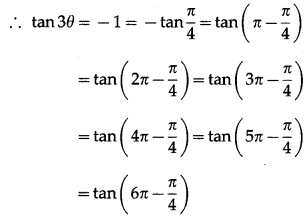
… [∵ tan(π – θ) = tan(2π – θ) = tan(3π – θ)
= tan (4π – θ) = tan (5π – θ) = tan (6π – θ) = -tan θ]
∴ tan3θ = tan\(\frac{3 \pi}{4}\) = tan\(\frac{7 \pi}{4}\) = tan\(\frac{11 \pi}{4}\) = tan\(\frac{15 \pi}{4}\)
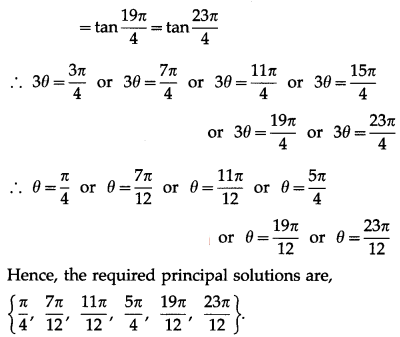
(iii) cotθ = 0
Solution:
cotθ = 0
Since θ ∈ (0, 2π),
cotθ = 0 = cot \(\frac{\pi}{2}\) = cot (π + \(\frac{\pi}{2}\) …[∵ cos(π + θ) = cotθ]
∴ cotθ = cot\(\frac{\pi}{2}\) = cot\(\frac{3 \pi}{2}\)
∴ θ = \(\frac{\pi}{2}\) or θ = \(\frac{3 \pi}{2}\)
Hence, the required principal solutions are \(\left\{\frac{\pi}{2}, \frac{3 \pi}{2}\right\}\)

Question 2.
Find the principal solutions of the following equations :
(i) sin2θ = \(-\frac{1}{\sqrt{2}}\)
Solution:
(ii) tan5θ = -1
Solution:
(iii) cot2θ = 0
Solution:
Question 3.
Which of the following equations have no solutions ?
(i) cos 2θ = \(\frac{1}{3}\)
Solution:
cos 2θ = \(\frac{1}{3}\)
Since \(\frac{1}{3}\) ≤ cosθ ≤ 1 for any θ
cos2θ = \(\frac{1}{3}\) has solution
(ii) cos
2
θ = -1
Solution:
cos2θ = -1
This is not possible because cos2θ ≥ 0 for any θ.
∴ cos2θ = -1 does not have any solution.
(iii) 2 sinθ = 3
Solution:
2 sin θ = 3 ∴ sin θ = \(\frac{3}{2}\)
This is not possible because -1 ≤ sin θ ≤ 1 for any θ.
∴ 2 sin θ = 3 does not have any solution.
(iv) 3 sin θ = 5
Solution:
3 sin θ = 5
∴ sin θ = \(\frac{5}{3}\)
This is not possible because -1 ≤ sin θ ≤ 1 for any θ.
∴ 3 sin θ = 5 does not have any solution.
Question 4.
Find the general solutions of the following equations :
(i) tanθ = \(-\sqrt {x}\)
Solution:
The general solution of tan θ = tan ∝ is
θ = nπ + ∝, n ∈ Z.
Now, tanθ = \(-\sqrt {x}\)
∴ tanθ = tan\(\frac{\pi}{3}\) …[∵ tan\(\frac{\pi}{3}\) = \(\sqrt {3}\)]
∴ tanθ = tan\(\left(\pi-\frac{\pi}{3}\right)\) …[∵ tan(π – θ) = -tanθ]
∴ tanθ = tan\(\frac{2 \pi}{3}\)
∴ the required general solution is
θ = nπ + \(\frac{2 \pi}{3}\), n ∈ Z.
(ii) tan
2
θ = 3
Solution:
The general solution of tan
2
θ = tan
2
∝ is
θ = nπ ± ∝, n ∈ Z.
Now, tan
2
θ = 3 = (\(\sqrt {x}\))
2
∴ tan
2
θ = (tan\(\frac{\pi}{3}\))
2
…[∵ tan\(\frac{\pi}{3}\) = \(\sqrt {3}\)]
∴ tan
2
θ = tan
2
\(\frac{\pi}{3}\)
∴ the required general solution is
θ = nπ ± \(\frac{\pi}{3}\), n ∈ Z.
(iii) sin θ – cosθ = 1
Solution:
∴ cosθ – sin θ = -1
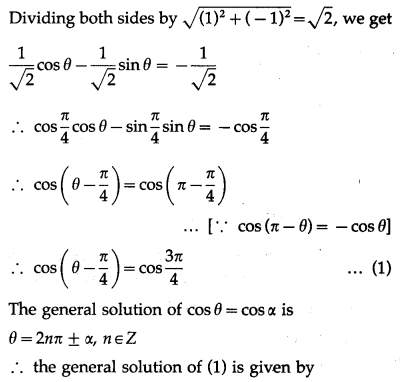

(iv) sin
2
θ – cos
2
θ = 1
Solution:
sin
2
θ – cos
2
θ = 1
∴ cos
2
θ – sin
2
θ = -1
∴ cos2θ = cosπ …(1)
The general solution of cos θ = cos ∝ is
θ = 2nπ ± ∝, n ∈ Z
∴ the general solution of (1) is given by
2θ = 2nπ ± π, n ∈ Z
∴ θ = nπ ± \(\frac{\pi}{2}\), n ∈ Z

Question 5.
In ∆ABC prove that cos \(\left(\frac{A-B}{2}\right)=\left(\frac{a+b}{c}\right)\) sin \(\frac{C}{2}\)
Solution:
By the sine rule,
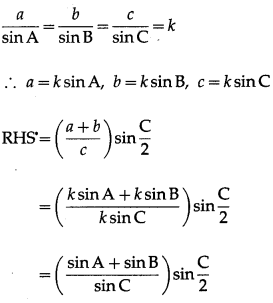
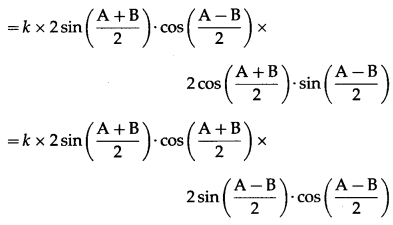
Question 6.
With usual notations prove that \(\frac{\sin (A-B)}{\sin (A+B)}=\frac{a^{2}-b^{2}}{c^{2}}\).
Solution:
By the sine rule,
\(\frac{a}{\sin \mathrm{A}}\) = \(\frac{b}{\sin \mathrm{B}}\) = \(\frac{c}{\sin \mathrm{C}}\) = k
∴ a = ksinA, b = ksinB, c = ksinC
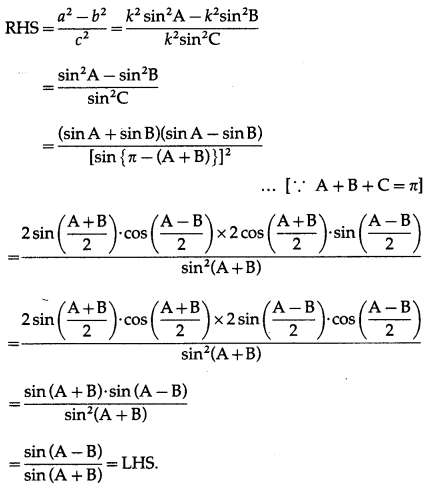
Question 7.
In ∆ABC prove that (a – b)
2
2cos
2
\(\frac{\mathrm{C}}{2}\) + (a + b)
2
sin
2
\(\frac{\mathrm{C}}{2}\) = c
2
.
Solution:
LHS (a – b)
2
2cos
2
\(\frac{\mathrm{C}}{2}\) + (a + b)
2
sin
2
\(\frac{\mathrm{C}}{2}\)
= (a
2
+ b
2
– 2ab) cos
2
\(\frac{\mathrm{C}}{2}\) + (a
2
+ b
2
+ 2ab) sin\(\frac{\mathrm{C}}{2}\)
2
= (a
2
+ b
2
) cos
2
\(\frac{\mathrm{C}}{2}\) – 2ab cos
2
\(\frac{\mathrm{C}}{2}\) + (a
2
+ b
2
) sin
2
\(\frac{\mathrm{C}}{2}\) + 2ab sin
2
\(\frac{\mathrm{C}}{2}\)
= (a
2
+ b
2
) (cos
2
\(\frac{\mathrm{C}}{2}\) + sin
2
\(\frac{\mathrm{C}}{2}\)) – 2ab(cos
2
\(\frac{\mathrm{C}}{2}\) – sin
2
\(\frac{\mathrm{C}}{2}\))
= a
2
+ b
2
– 2ab cos C
= c
2
= RHS.

Question 8.
In ∆ABC if cosA = sin B – cos C then show that it is a right angled triangle.
Solution:
cos A= sin B – cos C
∴ cos A + cos C = sin B
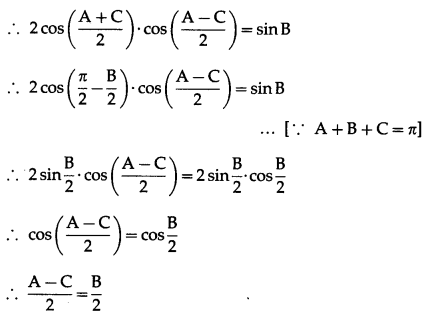
∴ A – C = B
∴ A = B + C
∴ A + B + C = 180° gives
A + A = 180°
∴ 2A = 180 ∴ A = 90°
∴ ∆ ABC is a rightangled triangle.
Question 9.
If \(\frac{\sin A}{\sin C}=\frac{\sin (A-B)}{\sin (B-C)}\) then show that a
2
, b
2
, c
2
, are in A.P.
Solution:
By sine rule,
\(\frac{\sin \mathrm{A}}{a}\) = \(\frac{\sin \mathrm{B}}{b}\) = \(\frac{\sin \mathrm{C}}{c}\) = k
∴ sin A = ka, sin B = kb,sin C = kc
Now, \(\frac{\sin A}{\sin C}=\frac{\sin (A-B)}{\sin (B-C)}\)
∴ sinA∙sin(B – C) = sinC∙sin(A -B)
∴ sin [π – (B + C)] ∙ sin (B – C)
= sin [π – (A + B)]∙sin (A – B) … [∵ A + B + C = π]
∴ sin(B + C) ∙ sin(B – C) = sin (A + B) ∙ sin (A – B)
∴ sin
2
B – sin
2
C = sin
2
A – sin
2
B
∴ 2 sin
2
B = sin
2
A + sin
2
C
∴ 2k
2
b
2
= k
2
a
2
+ k
2
c
2
∴ 2b
2
= a
2
+ c
2
Hence, a
2
, b
2
, c
2
are in A.P.
Question 10.
Solve the triangle in which a = (\(\sqrt {3}\) + 1), b = (\(\sqrt {3}\) – 1) and ∠C = 60°.
Solution:
Given : a = \(\sqrt {3}\) + 1, b = \(\sqrt {3}\) – 1 and ∠C = 60°.
By cosine rule,
c
2
= a
2
+ b
2
– 2ab cos C
= (\(\sqrt {3}\) + 1)
2
+ (\(\sqrt {3}\) – 1)
2
– 2(\(\sqrt {3}\) + 1)(\(\sqrt {3}\) – 1)cos60°
= 3 + 1 + 2\(\sqrt {3}\) + 3+ 1 – 2\(\sqrt {3}\) – 2(3 – 1)\(\left(\frac{1}{2}\right)\)
= 8 – 2 = 6
∴ c = \(\sqrt {6}\) …[∵ c > 0)
By sine rule,
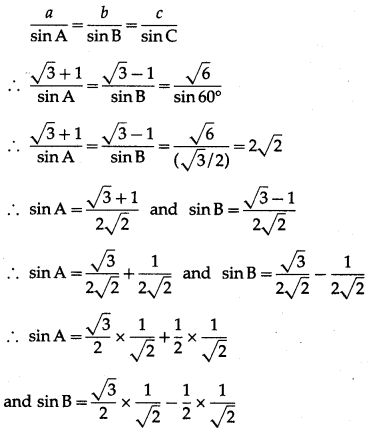
∴ sin A = sin 60° cos 45° + cos 60° sin 45°
and sin B = sin 60° cos 45° – cos 60° sin 45°
∴ sin A = sin (60° + 45°) – sin 105°
and sin B = sin (60° – 45°) = sin 15°
∴ A = 105° and B = 15°
Hence, A = 105°, B 15° and C = \(\sqrt {6}\) units.
Question 11.
In ∆ABC prove the following :
(i) a sin A – b sin B = c sin (A – B)
Solution:
By sine rule,
\(\frac{a}{\sin \mathrm{A}}\) = \(\frac{b}{\sin \mathrm{B}}\) = \(\frac{c}{\sin \mathrm{C}}\) = k
∴ a = ksinA, b = ksinB, c = ksinC,
LHS = a sin A – b sinB
= ksinA∙sinA – ksinB∙sinB
= k (sin
2
A – sin
2
B)
= k (sin A + sin B)(sin A – sin B)

= k × sin (A + B) × sin (A – B)
= ksin(π – C)∙sin(A – B) … [∵ A + B + C = π]
= k sinC∙sin (A – B)
= c sin (A – B) = RHS.
(ii) \(\frac{c-b \cos A}{b-c \cos A}=\frac{\cos B}{\cos C}\).
Solution:
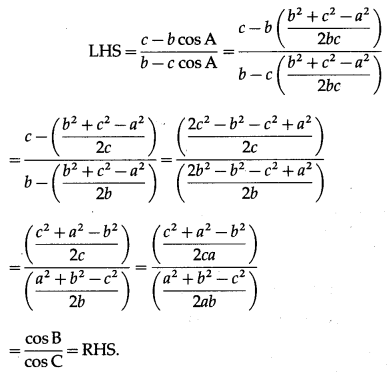
(iii) a
2
sin (B – C) = (b
2
– c
2
) sinA
Solution:
By sine rule,
\(\frac{a}{\sin \mathrm{A}}\) = \(\frac{b}{\sin \mathrm{B}}\) = \(\frac{c}{\sin \mathrm{C}}\) = k
∴ a = ksinA, b = ksinB, c = ksinC
RHS = (b
2
– c
2
) sin A
= (k
2
sin
2
B – k
2
sin
2
C)sin A
= k
2
(sin
2
B – sin
2
C) sin A
= k
2
(sin B + sin C)(sin B – sin C) sin A
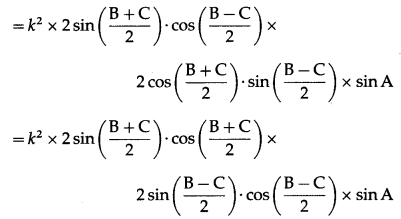
= k
2
× sin (B + C) × sin (B – C) × sin A
= k
2
∙sin(π – A)∙sin(B – C)∙sinA … [∵ A + B + C = π]
= k
2
sin A∙sin (B – C)∙sin A
= (k sin A)
2
∙sin (B – C)
= a
2
sin (B – C) = LHS.
(iv) ac cos B – bc cos A = (a
2
– b
2
).
Solution:
LHS = ac cos B – bc cos A
= ac\(\left(\frac{c^{2}+a^{2}-b^{2}}{2 c a}\right)\) – bc\(\left(\frac{b^{2}+c^{2}-a^{2}}{2 b c}\right)\)
=\(\frac{1}{2}\)(c
2
+ a
2
– b
2
) – \(\frac{1}{2}\)(b
2
+ c
2
– a
2
)
= \(\frac{1}{2}\)(c
2
+ a
2
– b
2
– b
2
– c
2
+ a
2
)
= \(\frac{1}{2}\)(2a
2
– 2b
2
) = a
2
– b2 = RHS.

(v) \(\frac{\cos A}{a}+\frac{\cos B}{b}+\frac{\cos C}{c}=\frac{a^{2}+b^{2}+c^{2}}{2 a b c}\) .
Solution:
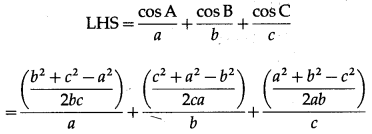
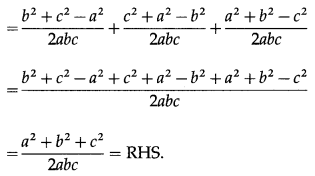
(vi) \(\frac{\cos 2 \mathrm{~A}}{a^{2}}-\frac{\cos 2 \mathrm{~B}}{b^{2}}=\frac{1}{a^{2}}-\frac{1}{b^{2}}\).
Solution:
By sine rule,
\(\frac{\sin \mathrm{A}}{a}=\frac{\sin \mathrm{B}}{b}\)
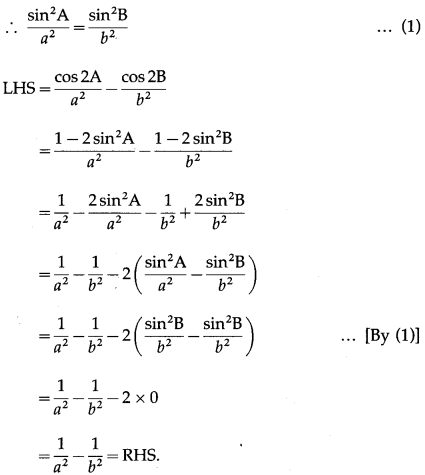
(vii) \(\frac{b-c}{a}=\frac{\tan \frac{B}{2}-\tan \frac{C}{2}}{\tan \frac{B}{2}+\tan \frac{C}{2}}\)
Solution:
By sine rule,
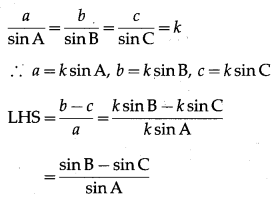
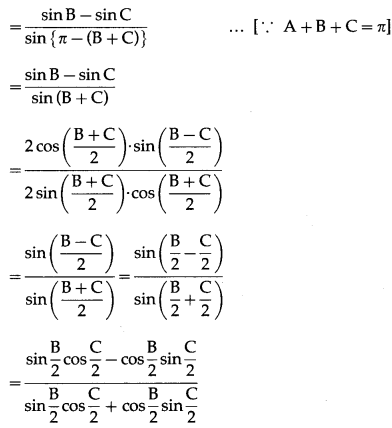
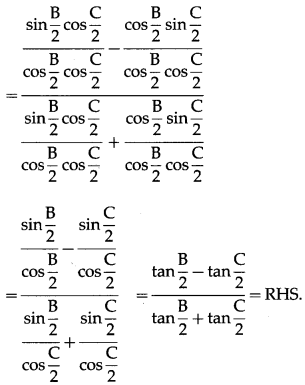
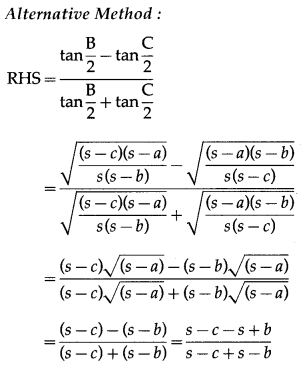
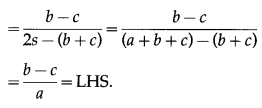
Question 12.
In ∆ABC if a
2
, b
2
, c
2
, are in A.P. then cot\(\frac{A}{2}\), cot\(\frac{B}{2}\), cot\(\frac{C}{2}\) are also in A.P.
Question is modified
In ∆ABC if a, b, c, are in A.P. then cot\(\frac{A}{2}\), cot\(\frac{B}{2}\), cot\(\frac{C}{2}\) are also in A.P.
Solution:
a, b, c, are in A.P.
∴ 2b = a + c …(1)
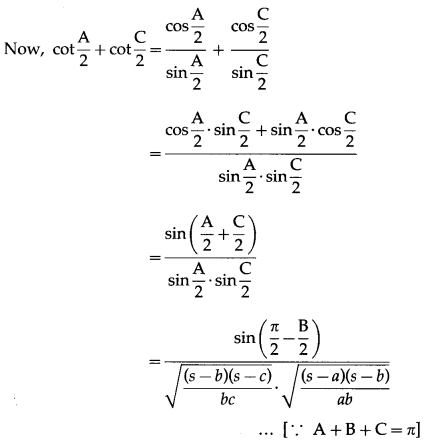
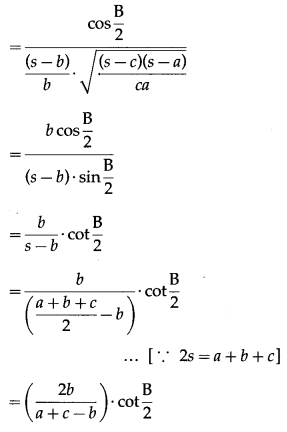

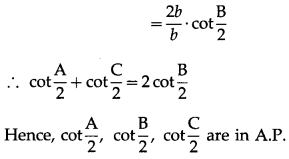
Question 13.
In ∆ABC if ∠C = 90º then prove that sin(A – B) = \(\frac{a^{2}-b^{2}}{a^{2}+b^{2}}\)
Solution:
In ∆ABC, if ∠C = 90º
∴ c
2
= a
2
+ b
2
…(1)
By sine rule,
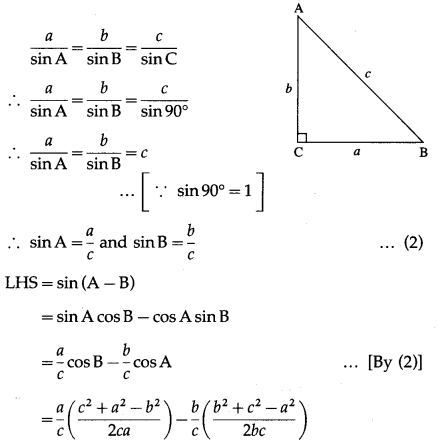
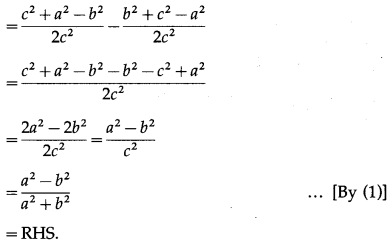
Question 14.
In ∆ABC if \(\frac{\cos A}{a}=\frac{\cos B}{b}\), then show that it is an isosceles triangle.
Solution:
Given : \(\frac{\cos A}{a}=\frac{\cos B}{b}\) ….(1)
By sine rule,
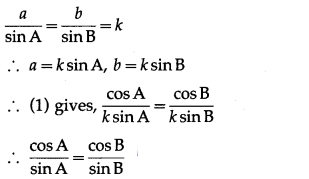
∴ sin A cos B = cos A sinB
∴ sinA cosB – cosA sinB = 0
∴ sin (A – B) = 0 = sin0
∴ A – B = 0 ∴ A = B
∴ the triangle is an isosceles triangle.
Question 15.
In ∆ABC if sin
2
A + sin
2
B = sin
2
C then prove that the triangle is a right angled triangle.
Question is modified
In ∆ABC if sin
2
A + sin
2
B = sin
2
C then show that the triangle is a right angled triangle.
Solution:
By sine rule,
\(\frac{\sin \mathrm{A}}{a}\) = \(\frac{\sin \mathrm{B}}{b}\) = \(\frac{\sin \mathrm{C}}{c}\) = k
∴ sin A = ka, sinB = kb, sin C = kc
∴ sin
2
A + sin
2
B = sin
2
C
∴ k
2
a
2
+ k
2
b
2
= k
2
c
2
∴ a
2
+ b
2
= c
2
∴ ∆ABC is a rightangled triangle, rightangled at C.

Question 16.
In ∆ABC prove that a
2
(cos
2
B – cos
2
C) + b
2
(cos
2
C – cos
2
A) + c
2
(cos
2
A – cos
2
B) = 0.
Solution:
By sine rule,
\(\frac{a}{\sin \mathrm{A}}\) = \(\frac{b}{\sin \mathrm{B}}\) = \(\frac{c}{\sin \mathrm{C}}\) = k
LHS = a
2
(cos
2
B – cos
2
C) + b
2
( cos
2
C – cos
2
A) + c
2
(cos
2
A – cos
2
B)
= k
2
sin
2
A [(1 – sin
2
B) – (1 – sin
2
C)] + k
2
sin
2
B [(1 – sin
2
C) – (1 – sin
2
A)] + k
2
sin
2
C[(1 – sin
2
A) – (1 – sin
2
B)]
= k
2
sin
2
A (sin
2
C – sin
2
B) + k
2
sin
2
B(sin
2
A – sin
2
C) + k
2
sin
2
C (sin
2
B – sin
2
A)
= k
2
(sin
2
A sin
2
C – sin
2
Asin
2
B + sin
2
A sin
2
B – sin
2
B sin
2
C + sin
2
B sin
2
C – sin
2
A sin
2
C)
= k
2
(0) = 0 = RHS.
Question 17.
With usual notations show that (c
2
– a
2
+ b
2
) tan A = (a
2
– b
2
+ c
2
) tan B = (b
2
– c
2
+ a
2
) tan C.
Solution:
By sine rule,
\(\frac{a}{\sin A}\) = \(\frac{b}{\sin B}\) = \(\frac{c}{\sin C}\) = k
∴ a = fksinA, b = ksinB, c = ksinC
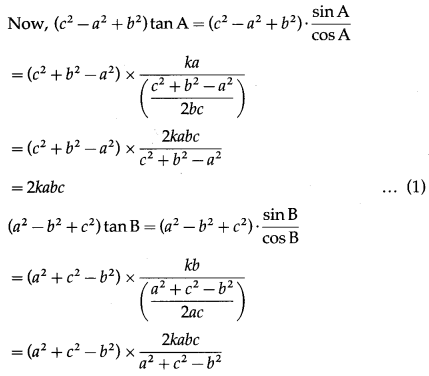
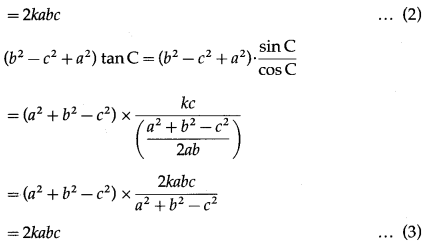
From (1), (2) and (3), we get
(c
2
– a
2
+ b
2
) tan A = (a
2
– b
2
+ c
2
) tan B
= (b
2
– c
2
+ a
2
) tan C.
Question 18.
In ∆ABC, if a cos
2
\(\frac{C}{2}\) + c cos
2
\(\frac{A}{2}\) = \(\frac{3 b}{2}\), then prove that a , b ,c are in A.P.
Solution:
a cos
2
\(\frac{C}{2}\) + c cos
2
\(\frac{A}{2}\) = \(\frac{3 b}{2}\)
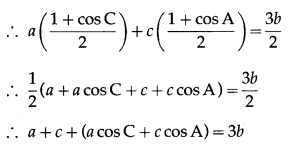
∴ a + c + b = 3b …[∵ a cos C + c cos A = b]
∴ a + c = 2b
Hence, a, b, c are in A.P.

Question 19.
Show that 2 sin
-1
\(\left(\frac{3}{5}\right)\) = tan
-1
\(\left(\frac{24}{7}\right)\).
Solution:
Let sin
2
\(\left(\frac{3}{5}\right)\) = x.
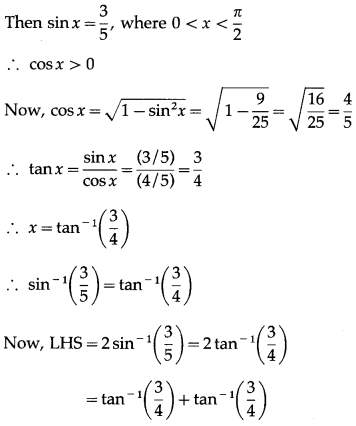
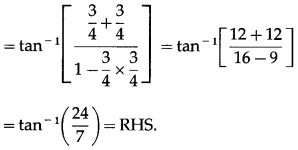
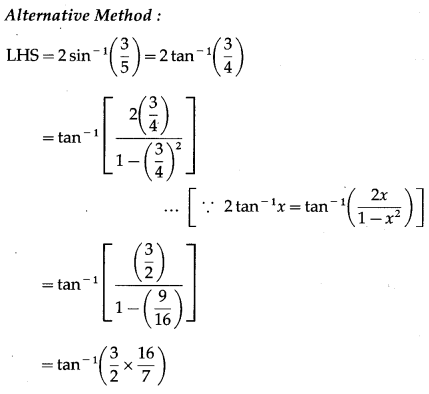
∴ tan
-1
\(\left(\frac{24}{7}\right)\) = RHS
Question 20.
Show that tan
-1
\(\left(\frac{1}{5}\right)\) + tan
-1
\(\left(\frac{1}{7}\right)\) + tan
-1
\(\left(\frac{1}{3}\right)\) + tan
-1
\(\left(\frac{1}{8}\right)\) = \(\frac{\pi}{4}\).
Solution:
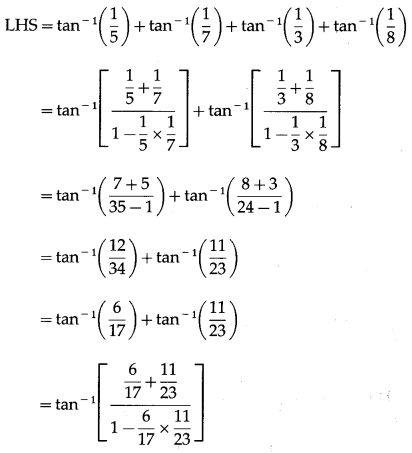
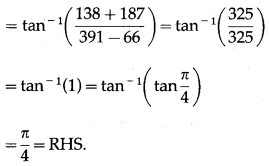
Question 21.
Prove that tan
-1
\(\sqrt {x}\) = \(\frac{1}{2}\) cos
-1
\(\left(\frac{1-x}{1+x}\right)\), if x ∈ [0, 1].
Solution:
Let tan
-1
\(\sqrt {x}\) = y
∴ tan y = \(\sqrt {x}\) ∴ x = tan
2
y
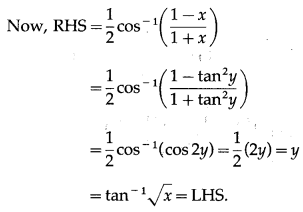
Question 22.
Show that \(\frac{9 \pi}{8}-\frac{9}{4}\) sin
-1
\(\frac{1}{3}\) = \(\frac{9}{4}\) sin
-1
\(\frac{2 \sqrt{2}}{3}\).
Question is modified
Show that \(\frac{9 \pi}{8}-\frac{9}{4}\) sin
-1
\(\left(\frac{1}{3}\right)\) = \(\frac{9}{4}\) sin
-1
\(\left(\frac{2 \sqrt{2}}{3}\right)\).
Solution:
We have to show that
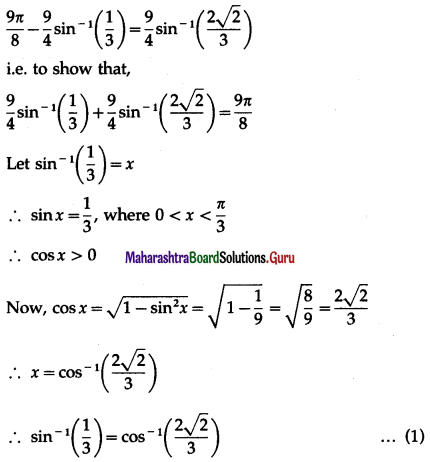
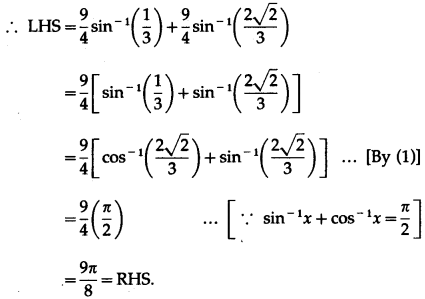

Question 23.
Show that
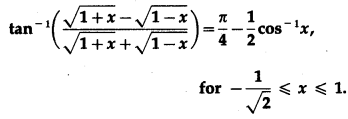
Solution:
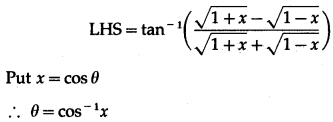
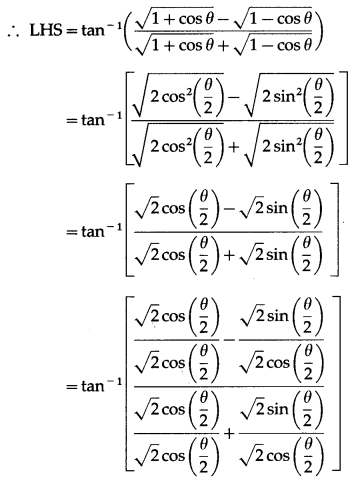
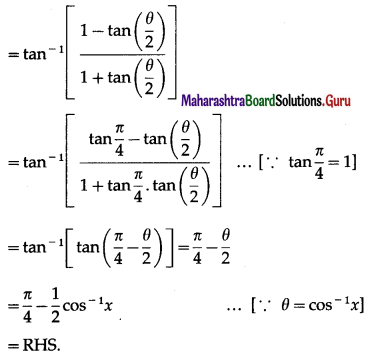
Question 24.
If sin(sin
-1
\(\frac{1}{5}\) + cos
-1
x) = 1, then find the value of x.
Solution:
sin(sin
-1
\(\frac{1}{5}\) = 1

Question 25.
If tan
-1
\(\left(\frac{x-1}{x-2}\right)\) + tan
-1
\(\left(\frac{x+1}{x+2}\right)\) = \(\frac{\pi}{4}\) then find the value of x.
Solution:
tan
-1
\(\left(\frac{x-1}{x-2}\right)\) + tan
-1
\(\left(\frac{x+1}{x+2}\right)\) = \(\frac{\pi}{4}\)

∴ x = ±\(\frac{1}{\sqrt{2}}\).
Question 26.
If 2 tan
-1
(cos x ) = tan
-1
(cosec x) then find the value of x.
Solution:
2 tan
-1
(cos x ) = tan
-1
(cosec x)


Question 27.
Solve: tan
-1
\(\left(\frac{1-x}{1+x}\right)\) = \(\frac{1}{2}\)(tan
-1
x), for x > 0.
Solution:
tan
-1
\(\left(\frac{1-x}{1+x}\right)\) = \(\frac{1}{2}\)(tan
-1
x)
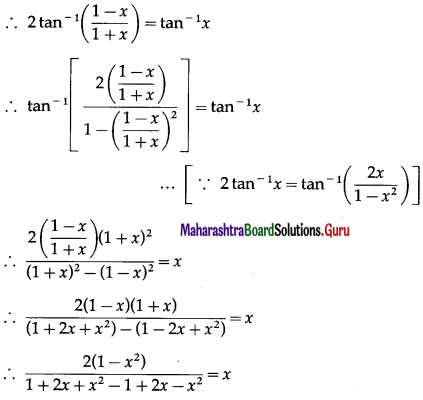
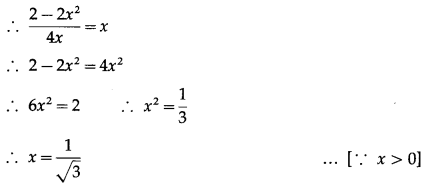
Question 28.
If sin
-1
(1 – x) – 2sin
-1
x = \(\frac{\pi}{2}\), then find the value of x.
Solution:
sin
-1
(1 – x) – 2sin
-1
x = \(\frac{\pi}{2}\)
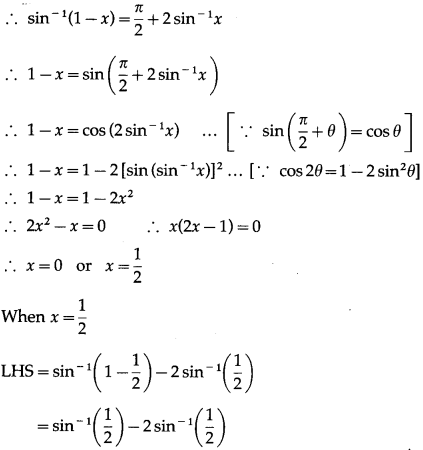
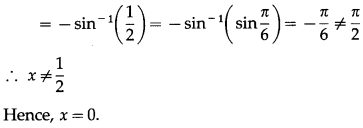
Question 29.
If tan
-1
2x + tan
-1
3x = \(\frac{\pi}{4}\), then find the value of x.
Question is modified
If tan
-1
2x + tan
-1
3x = \(\frac{\pi}{2}\), then find the value of x.
Solution:
tan
-1
2x + tan
-1
3x = \(\frac{\pi}{4}\)
∴ tan
-1
\(\left(\frac{2 x+3 x}{1-2 x \times 3 x}\right)\) = tan\(\frac{\pi}{4}\), where 2x > 0, 3x > 0
∴ \(\frac{5 x}{1-6 x^{2}}\) = tan\(\frac{\pi}{4}\) = 1
∴ 5x = 1 – 6x
2
∴ 6x
2
+ 5x – 1 = 0
∴ 6x
2
+ 6x – x – 1 = 0
∴ 6x(x +1) – 1(x + 1) = 0
∴ (x + 1)(6x – 1) = 0
∴ x = -1 or x = \(\frac{1}{6}\)
But x > 0 ∴ x ≠ -1
Hence, x = \(\frac{1}{6}\)
Question 30.
Show that tan
-1
\(\frac{1}{2}\) – tan
-1
\(\frac{1}{4}\) = tan
-1
\(\frac{2}{9}\).
Solution:
LHS = tan
-1
\(\frac{1}{2}\) – tan
-1
\(\frac{1}{4}\)
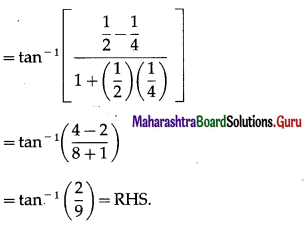

Question 31.
Show that cot
-1
\(\frac{1}{3}\) – tan
-1
\(\frac{1}{3}\) = cot
-1
\(\frac{3}{4}\).
Solution:
LHS = cot
-1
\(\frac{1}{3}\) – tan
-1
\(\frac{1}{3}\)
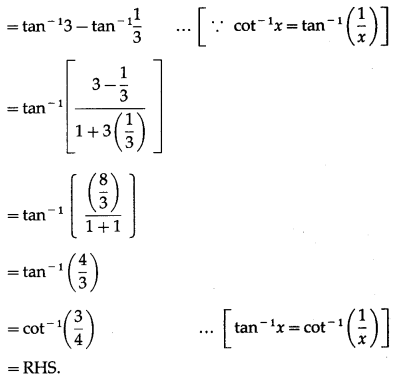
Question 32.
Show that tan
-1
\(\frac{1}{2}\) = \(\frac{1}{3}\) tan
-1
\(\frac{11}{2}\).
Solution:
We have to show that
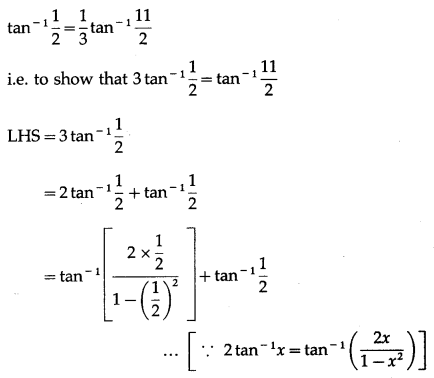
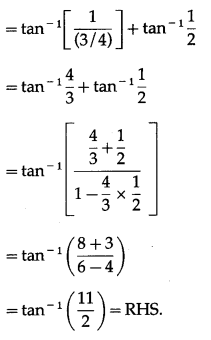

Question 33.
Show that cos
-1
\(\frac{\sqrt{3}}{2}\) + 2sin
-1
\(\frac{\sqrt{3}}{2}\) = \(\frac{5 \pi}{6}\)
Solution:
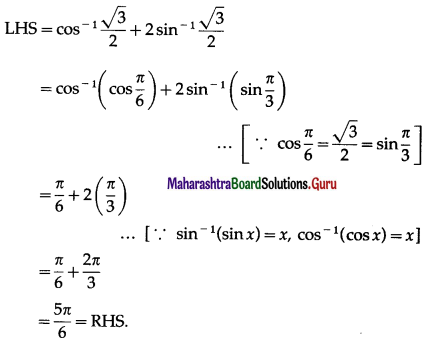
Question 34.
Show that 2cot
-1
\(\frac{3}{2}\) + sec
-1
\(\frac{13}{12}\) = \(\frac{\pi}{2}\)
Solution:
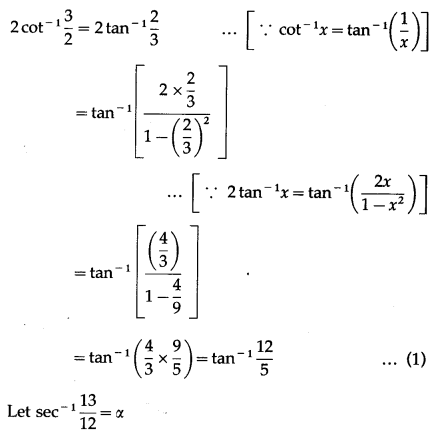
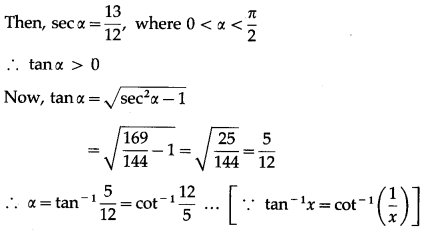
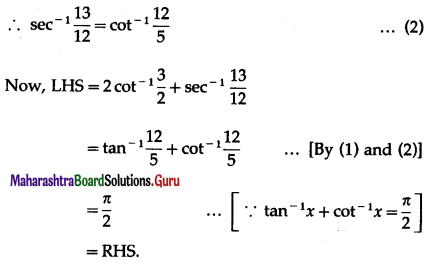
Question 35.
Prove the following :
(i) cos
-1
x = tan
-1
\(\frac{\sqrt{1-x^{2}}}{x}\), if x < 0.
Question is modified
cos
-1
x = tan
-1
\(\left(\frac{\sqrt{1-x^{2}}}{x}\right)\), if x > 0.
Solution:
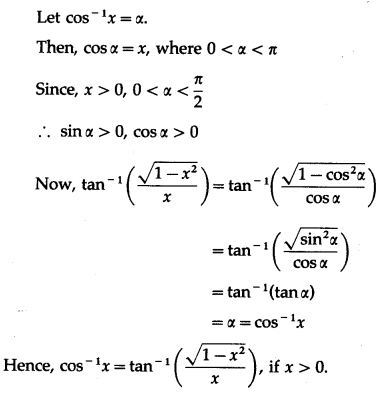
(ii) cos
-1
x = π + tan
-1
\(\frac{\sqrt{1-x^{2}}}{x}\), if x < 0.
Solution:
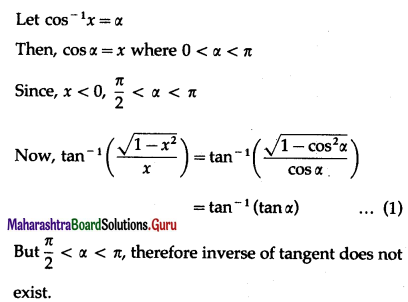
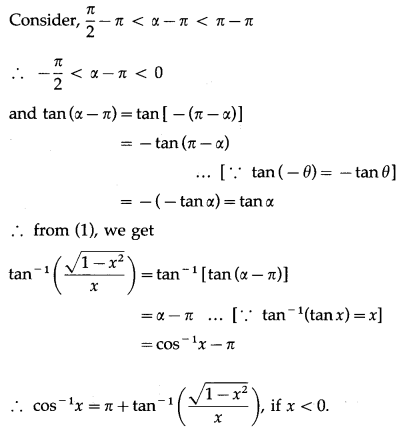

Question 36.
If |x| < 1 , then prove that 2tan
-1
x = tan
-1
\(\frac{2 x}{1-x^{2}}\) = sin
-1
\(\frac{2 x}{1+x^{2}}\) = cos
-1
\(\frac{1-x^{2}}{1+x^{2}}\)
Question is modified
If |x| < 1 , then prove that 2tan
-1
x = tan
-1
\(\left(\frac{2 x}{1-x^{2}}\right)\) = sin
-1
\(\left(\frac{2 x}{1+x^{2}}\right)\) = cos
-1
\(\left(\frac{1-x^{2}}{1+x^{2}}\right)\)
Solution:
Let tan
-1
x = y
Then, x = tany
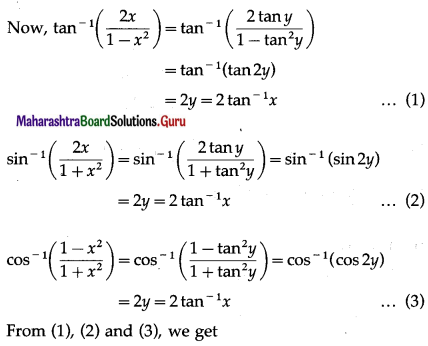
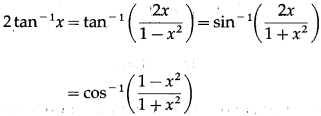
Question 37.
If x, y, z, are positive then prove that tan
-1
\(\frac{x-y}{1+x y}\) + tan
-1
\(\frac{y-z}{1+y z}\) + tan
-1
\(\frac{z-x}{1+z x}\) = 0
Solution:

Question 38.
If tan
-1
x + tan
-1
y + tan
-1
z = \(\frac{\pi}{2}\) then, show that xy + yz + zx = 1
Solution:
tan
-1
x + tan
-1
y + tan
-1
z = \(\frac{\pi}{2}\)
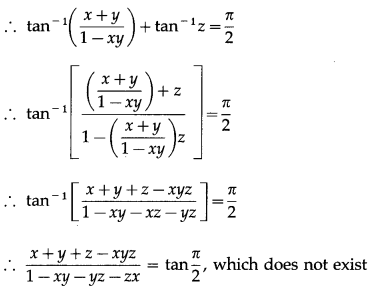
∴ 1 – xy – yz – zx = 0
∴ xy + yz + zx = 1.

Question 39.
If cos
-1
x + cos
-1
y + cos
-1
z = π then show that x
2
+ y
2
+ z
2
+ 2xyz = 1.
Solution:
0 ≤ cos
-1
x ≤ π and
cos
-1
x + cos
-1
y+ cos
-1
z = 3π
∴ cos
-1
x = π, cos
-1
y = π and cos
-1
z = π
∴ x = y = z = cosπ = -1
∴ x
2
+ y
2
+ z
2
+ 2xyz
= (-1)
2
+ (-1)
2
+ (-1)
2
+ 2(-1)(-1)(-1)
= 1 + 1 + 1 – 2
= 3 – 2 = 1.

